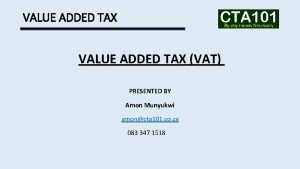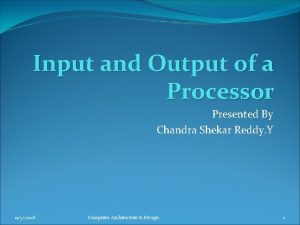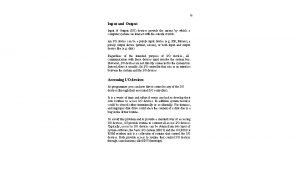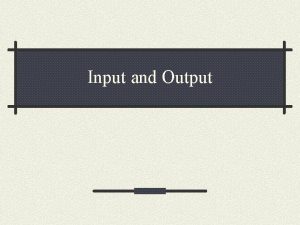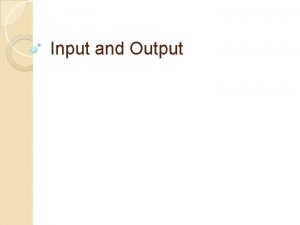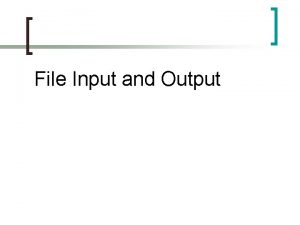Tutorial on Output Prices Input Prices and Factor



![Output-input prices and factor reallocation Factor mobility Factor market equilibrium • [PL]A = [PL]M Output-input prices and factor reallocation Factor mobility Factor market equilibrium • [PL]A = [PL]M](https://slidetodoc.com/presentation_image_h2/2ccb36e32226db9ddf9809effcd802ec/image-4.jpg)

![Output-input prices and factor reallocation Initial goods market equilibrium, South [Q 0]S = [QA]0, Output-input prices and factor reallocation Initial goods market equilibrium, South [Q 0]S = [QA]0,](https://slidetodoc.com/presentation_image_h2/2ccb36e32226db9ddf9809effcd802ec/image-6.jpg)




- Slides: 10

Tutorial on Output Prices, Input Prices and Factor Reallocation The Microeconomics of International Trade ECN 230 Roberto J. Garcia School of Economics and Business, NMBU Sessions 5 -6

Output-input prices and factor reallocation Producer theory: input markets Marginal productivity (MP) MP of labor, ∂Q/∂L • Increasing labor input will increase output • ↑ LA → ↑ QA or [∂QA/∂LA] ==> [MPL]A > 0 • ↑ LM → ↑ QM or [∂QM/∂LM] ==> [MPL]M > 0 MP of capital, ∂Q/∂K • Increasing capital input will increase output • ↑ KA → ↑ QA [∂QA/∂KA] ==> [MPK]A > 0 • ↑ KM → ↑ QM [∂QM/∂KM] ==> [MPK]M > 0 Decreasing MPL, MPK • Further additions of an input will increase output at a lower rate • [∂2 QA/∂LA 2] < 0 and [∂2 QM/∂LM 2] < 0 • [∂2 QA/∂KA 2] < 0 and [∂2 QM/∂KM 2] < 0 1

Output-input prices and factor reallocation Marginal productivity and wages Value of the marginal product of an input (VMP) • Input price = value of the marginal product (MP) of the input • VMP of input = output price x MP of the input • VMP in the factor markets (L, K) Labor market Capital market s [PL]A = PA ∙ [MPL]A s [PL]M = PM ∙ [MPL]M [PK]A = PA ∙ [MPK]A [PK]M = PM ∙ [MPK]M Input-output price relationship – what causes ↑PL, PK? • Labor market: ↑[PL]A, [PL]M s ↑PA → ↑PL holding [MPL]A constant; or ↑[MPL]A → ↑[PL]A at constant PA s ↑PM → ↑PL holding [MPL]M constant; or ↑[MPL]M → ↑[PL]M at constant PM • Capital market: ↑[PK]A, [PK]M s ↑PA → ↑PK holding [MPK]A constant; or ↑[MPK]A → ↑[PK]A at constant PA s ↑PM → ↑PK holding [MPK]M constant; or ↑[MPK]M → ↑[PK]M at constant PM 2
![Outputinput prices and factor reallocation Factor mobility Factor market equilibrium PLA PLM Output-input prices and factor reallocation Factor mobility Factor market equilibrium • [PL]A = [PL]M](https://slidetodoc.com/presentation_image_h2/2ccb36e32226db9ddf9809effcd802ec/image-4.jpg)
Output-input prices and factor reallocation Factor mobility Factor market equilibrium • [PL]A = [PL]M if labor is perfectly mobile between sectors • [PK]A = [PK]M if capital is perfectly mobile between sectors Factor reallocation when factor prices not equalized • Labor market: [PL]A ≠ [PL]M s s [PL]A > [PL]M implies L moves from M-sector to A-sector Migration into A-sector: ↑LA → ↓ [PL]A Migration out of M-sector: ↓LM → ↑ [PL]M Factor reallocation until [PL]A = [PL]M • Capital market: [PK]A ≠ [PK]M s s [PK]A > [PK]M implies K moves from M-sector to A-sector Migration into A-sector: ↑KA → ↓ [PK]A Migration out of M-sector: ↓KM → ↑ [PK]M Factor reallocation until [PK]A = [PK]M 3

Output-input prices and factor reallocation Graphical representation of labor market Labor in the agricultural sector • To produce [QA]0, [LA]0 units are employed in the A-sector • [PL]A is the equilibrium wage rate in the A-sector Labor in the manufacturing sector • To produce [QM]0, [LM]0 units are employed in the M-sector • [PL]M is the equilibrium wage rate in the M-sector 4
![Outputinput prices and factor reallocation Initial goods market equilibrium South Q 0S QA0 Output-input prices and factor reallocation Initial goods market equilibrium, South [Q 0]S = [QA]0,](https://slidetodoc.com/presentation_image_h2/2ccb36e32226db9ddf9809effcd802ec/image-6.jpg)
Output-input prices and factor reallocation Initial goods market equilibrium, South [Q 0]S = [QA]0, [QM]0 units produced in South • Ag sector: [LA]0, [KA]0 units employed to produce [QA]0 • Manu sector: [LM]0, [KM]0 units employed to produce [QM]0 Full employment: L, K employed to produce QA and QM • [LA]0 + [LM]0 = L • [KA]0 + [KM]0 = K South 5

Output-input prices and factor reallocation Free trade: ΔP and effect on output in South Ag sector • ↑[PA]S from [PA]S to [PA]W • ↑[PA]S → ↑[QA]S from [QA]0 to [QA]1 units produced in South Manu sector • ↓[PM]S from [PM]S to [PM]W • ↓[PM]S → ↓[QM]S from [QM]0 to [QM]1 units produced in South 6

Output-input prices and factor reallocation Trade effect on input-output price relationship, South Effect on labor in the agricultural sector • ↑PA → ↑QA ==> ↑ LA from [LA]0 units to [LA]1 units • [PL]A = PA ∙ [MPL]A ==> ↑PA → ↑ [PL]A Effect on labor in the manufacturing sector • ↓PM → ↓QM ==> ↓ LM from [LM]0 units to [LM]1 units • [PL]M = PM ∙ [MPL]M ==> ↓PM → ↓ [PL]M Overall effect: ↑PL and ↑PL relative to PK 7

Output-input prices and factor reallocation Trade effect on labor reallocation, South Change in relative output prices and PPC • Δ relative factor prices on agriculture • Δ relative factor prices on manufacturing • L moves to A-sector: ↑LA = ↓ LM Economy of South 8

Output-input prices and factor reallocation Concluding comments General lessons from the results • Trade liberalization affects (relative) output prices s South: ↑PA, ↓PM and ↑PA relative to PM s North: ↑PM, ↓PA and ↓PA relative to PM • Changes in relative output prices affects (relative) input prices s South: ↑PA → ↑ [PL]; ↓PM → ↓[PK] and ↑[PA/PM] → ↑ [PL/PK] s North: ↑PM → ↑ [PK]; ↓PA → ↓[PL] and ↓[PA/PM] → ↓ [PL/PK] • South (North) with a comparative advantage in agriculture (manufacturing) and relatively endowed with labor (capital) sees ↑PA and PL (↑PM and PK) as trade is liberalized • Winners and losers: returns to abundant factor increases while returns to scarce factor decreases Limitations and weaknesses of the model • In reality factors are not perfectly mobile between sectors • Factor prices do not equalize across sectors • Many other factors affect returns to labor and capital apart from 9 output prices and marginal productivity
 What is form control in system analysis and design
What is form control in system analysis and design Advantages of manual input devices
Advantages of manual input devices Output devices in virtual reality
Output devices in virtual reality Input vat and output vat
Input vat and output vat Vat input meaning
Vat input meaning Input vat
Input vat Conclusion for input and output devices of computer
Conclusion for input and output devices of computer Definition of input and output devices
Definition of input and output devices Conclusion for input and output devices of computer
Conclusion for input and output devices of computer Learning outcomes of input and output devices
Learning outcomes of input and output devices Example of input devices
Example of input devices




